The e-mail hit my inbox back in February. “June 1st–Advanced/Mega Civilization Game.”
My buddy John was hosting a birthday party. To celebrate, he wanted to whip out one of his old favorites, 2015’s Mega Civilization. Mega Civ, as it became known, comes in this massive wooden box with only its title on the outside, but the sheer weight of it (thanks, in part, to more than 2,000 tokens and 800 cards!!!) was something to behold.
At a gaming session last year, John handed me the box and promised that 2024 would be the first post-COVID run of Mega Civ he would host. “You gotta try it,” he said at the time. “It’s epic.”
“Epic” became the calling card for almost everything about Mega Civ. Mega Civ reimplements both the 1980 Francis Tresham design Civilization (not to be confused with, well, many other implementations of the Civilization title, some of which were designed by Sid Meier and/or based on the Civilization video games) and the 1991 expansion and rules update Advanced Civilization.
So, Mega Civ starts by being epic just by including so much game in one box. (Or, wooden crate.) The time commitment is massive—the game promises a playtime of 10-12 HOURS to complete. For new followers, please note that my sweet spot is anywhere from an hour (hello, The White Castle) to three hours if you’ve really got something juicy for me to do (Hegemony, anyone?).
But 10-12 hours required sign-off from the CEO: my wife. I tip-toed over to her one night after something that showed my worth, such as cleaning the entire house, taking the kids for the weekend, etc.
“Honey, my friend John wants to celebrate his birthday, so I’m hoping I can just be, you know, an absentee for an entire Saturday in early June.”
“I think that should work…what’s the occasion?”
“Well…we are going to play a game called Mega Civilization for anywhere from 10-12 hours while sitting around a number of large tables bartering for stone, cotton and silver and battling for supremacy in the Stone Age and subsequent eras of history.”
[blank stare] “Have a good time!”After getting sign-off at home, the prep kicked into high gear: I had to watch a series of teach videos (one featuring John and his wife Beth themselves, which was fun) and glance at a rulebook or two so that the teach on the day of the game wouldn’t be completely new information.
I knocked out the prep work, then made the drive to John’s place on the morning of June 1st. Let’s recount the day, to the best of my memory. Also, for the purposes of this rundown (and it is LONG, to align with the long day I spent playing the game), I will not spend time talking about some of the finer points regarding civilization games…so, if you are reading this and wondering “what’s a civ game?”, this piece is not for you!
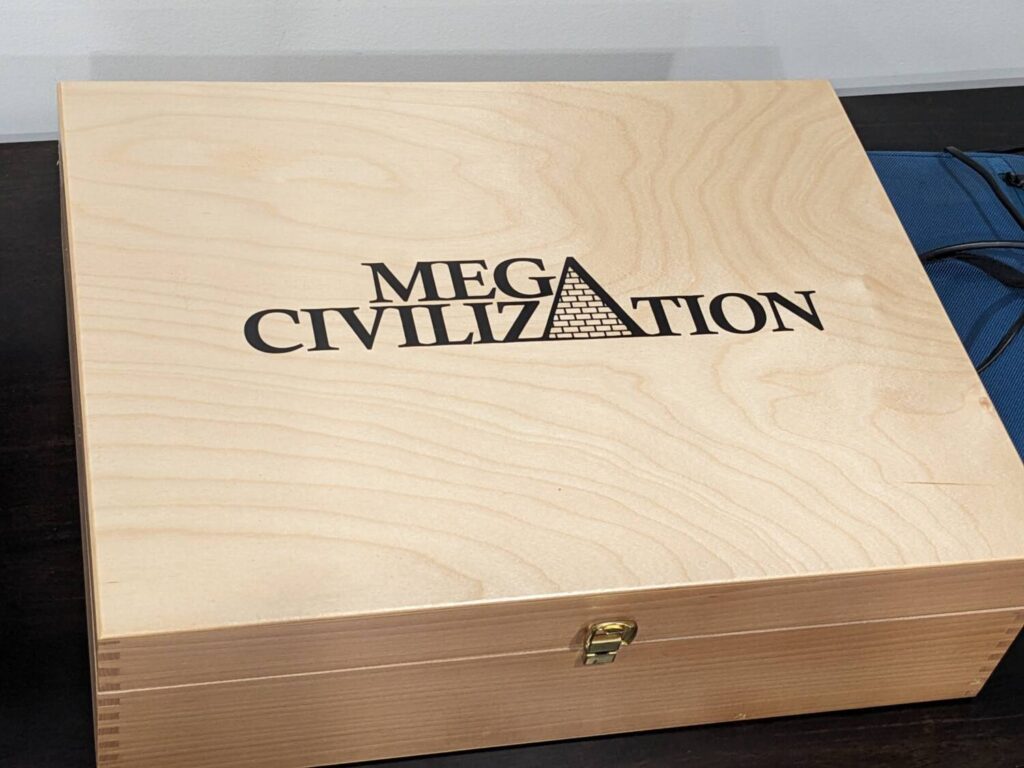
8:35 AM
I arrived at John’s house five minutes late but walked into a handsome spread of food that helped us load up for a day of calamities, city construction, trades, and conflict. That started with donuts, bagels, fruit and orange juice from 8:30-9 AM before we started the teach.
Our Mega Civ game had eight players: John, Beth, Dan, Clark, Brian, Jeff, Kayla, and me. Five of us had never played Mega Civ but everyone at the table was a seasoned gamer with quite a few years of gaming between us. I’ll note that one element was pretty lucky for me—everyone in this group of eight was a good listener who took relatively quick turns where possible. This game could have gone into the next day were it not for the size and speed of the group, so kudos to John for the big bonus of putting together a friendly, quick decision-making set of gamers.
Bonus #2: We used a Google Sheets file that did a lot of math for us regarding the discounts players will earn during play by buying certain types of technology cards. On the low end, I think this saved us 30-45 minutes, but likely much more. All players had to bring a laptop to the session and my Chromebook got the workout near the end of rounds when everyone went shopping for new cards. I can’t stress this enough: use a spreadsheet, people!!!

9:45 AM
Breakfast wrapped up, we finished the teach, then we were assigned our factions randomly. I drew the Indus, which has the benefit of being right in the middle of the action in case you want to start a few scraps here and there. Unfortunately, Mega Civ is not a wargame…it’s a civilization game that leans heavily on NOT fighting other factions, because it feels like everyone loses during combat in Mega Civ.
Instead, the Indus had a different problem: four other factions were my neighbors in the eight-player setup. I had to negotiate with four other players (John, Clark, Dan and Jeff) for almost everything all game long. This was more tiring (yet occasionally interesting as a result) than I initially gave it credit for, but at 9:45 AM, the sun was still shining in my world.
Players started to negotiate their first few land grabs right away, as expansion across the eastern portion of the map (think India, Persia, the “Fertile Crescent”) was going to be a doozy in the middle of the action. Some players didn’t bother talking to anyone. Brian, the Saba player (Northern Africa), seemed to have an entire expanse all to himself, which became a problem later in the game.
One other item we covered in detail before the game kicked off was the Archeological Succession Table, known in the game and my resulting nightmares as the AST. When it came down to final scoring, about 75% of a player’s final score came from their spot on the AST. So while there is not technically a public scoreboard in Mega Civ, the AST comes close. It also lays out the requirements to get through the gated spots on the track; for example, a player can only advance past the first gate on the AST if they have at least two cities.
Then, after initial negotiations ended, we started the game.

Around 10 AM
From maybe 10-10:30, we did a lot of simultaneous turns as we moved quickly through the empty phases during each of the first 3-4 rounds. In Mega Civ, each round has a whopping 13 phases, and some of them are bookkeeping: tax collection, expansion, movement (particularly when you don’t have anyone neighboring your region in the early going), and trading—both getting trade cards as well as the actual trading with your opponents.
We moved quickly through this section of the game then got into the heart of the matter. As the Indus community expanded, the tension (for me, at least) became palpable. I had neighbors…everywhere.
Dravidia (Dan) wasn’t knocking yet, but the way he was inching up the coastline told me that it wouldn’t be long before he might be docking a boat or two on Indus shorelines. Parthia (Jeff) and Persia (Kayla) knocked early, and we had to work out a few regions in real time. There was a small lake nearby that Kayla, Jeff and I all had eyes on, but that was also going to lead to some early conflict.
To my north, more problems. The Kushan (Clark) wanted to start divvying up spots too, but we were both worried about Maurya (John) because we knew we had to defend ourselves against westward expansion by the fine people of Maurya. John was also a vet at Mega Civ—it was his party, after all—and that led to even more wrangling. If John wanted to negotiate, what was his real plan? He keeps saying that “conflict is not the way to win in Mega Civ”, but why does he keep up his aggressive expansion if that wasn’t on his mind?
Looking back at the day now, despite my dissatisfaction with my starting location, I was really into things at this stage. I had four neighbors interested in negotiation. I had nowhere to run and hide, but I signed up for interaction and I was getting it. Also, growing from a city to two to four cities in quick succession felt like I was really building something, and when I started to get trade cards, it was fun to barter with others.
Trade cards are meant to be scored in sets; “scoring” them really means cashing them in for money that will be spent later for technology cards. These techs, formally known in Mega Civ as “Civilization Advances”, represent the secondary scoring element of Mega Civ that also grants each owner various defenses against the Calamity cards that wreck plans and entire civilizations during the game. You’re going to need some, as even the weaker Civilization Advances might save a city or keep your people from revolting later in the game.
During this portion of the day, I was loving Mega Civ. Sure, we were only about 90 minutes into the thing, but I could see the bones behind why John and so many others try to get a play of this game in every year. It is a game that has the makings of something epic.
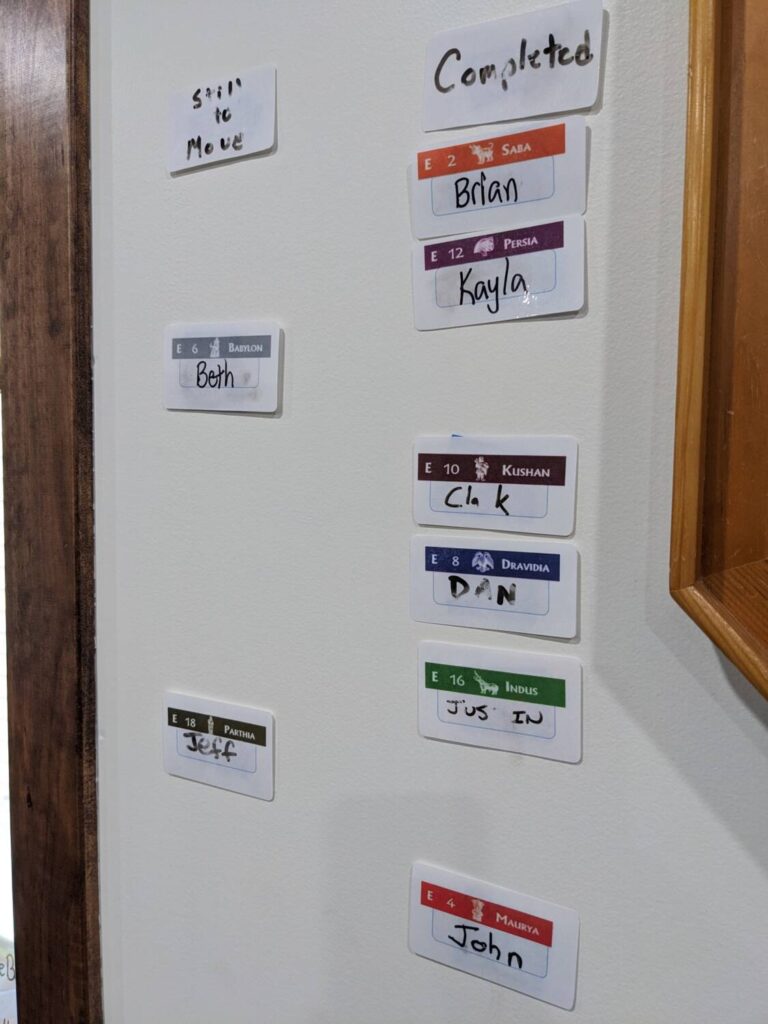
1:45 PM
We started a round and decided that after Civilization Advances were purchased, we would call in the lunch order so that we could eat in the 2-2:30 range.
It was around this time that my experience with Mega Civ began to change…and the moment was distinct.
Midway through that round’s trade phase, I was working the room trying to complete a set of something piddly, in the value one or two range (which would normally be something like flax or hides, but because we didn’t use the right cards for the Eastern setup, we just used ochre and clay from the Western setup). The way trade cards are granted, you get a certain number of cards equal to the number of cities you have on the map. At this stage, I had five cities.
I got my trade cards, added those to the ones I had from previous turns, then used our timed 10-minute trade interval to ask around and see who had ochre so that I could get a full set of 9 and have about 100 points to spend on cards later in the round. Most other players had about five cities too, so most of us were trading for things that everyone wanted.
Here’s how trades work in Mega Civ: you have to trade at least three cards, but you only have to be truthful about two of them. So, you could offer someone fish and clay, and for the third card, you could sneak something into the deal that you don’t really want, like a stray fruit card that is only good if you’ve got a lot of them, or water, which has a value of zero.
There is one other kind of card in the deck: calamities, dealt randomly from the trade goods draw deck. These cards are almost universally bad—in some cases, legitimately terrible—but the best way to move them out of your hand is to include them in trades. Over the course of the game, you just expect to get them, and hope you have the technologies to deal with them later in the round.
But during this particular turn, my hand began the trading phase “clean”: no calamity cards. No cyclones, no barbarian hordes, no volcanic eruptions, no famine. And I definitely didn’t want any calamity cards this round because I was hoping to keep my fledgling community intact just once, having previously been served low-level calamities in other rounds.
Eventually, I got into a trade negotiation with Dan, and we did a deal which got me the cards I needed to buy a couple Civilization Advance cards later. He also handed me Superstition, a calamity that would later require me to reduce three of my five cities. He smiled, with a nod that seemed to say “sorry, but that’s Mega Civ”, then moved on to his next trade opportunity.
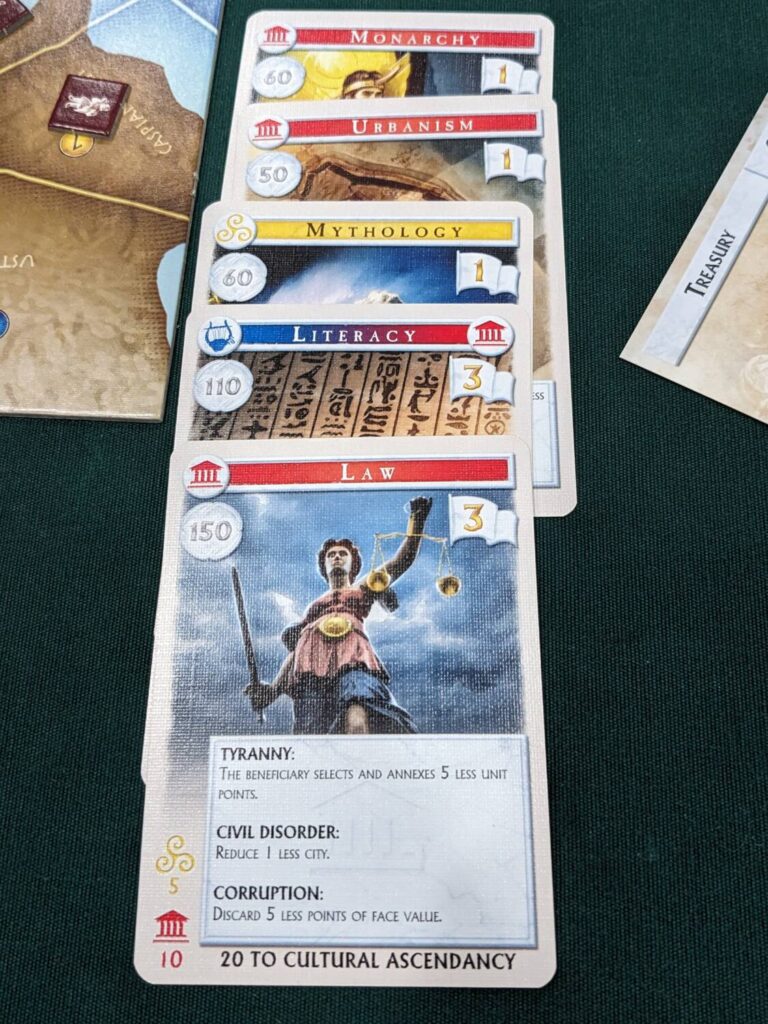
I was devastated, at least in the way that board games can be devastating, certainly a first-world problem. I had traded down to get low-level cards to begin with, only to also take a card that would take 60% of my cities out. The way cities get rebuilt would take a turn or two; nothing out of control, but it also meant that my tax rate for the next round would leave the Indus with less cash to supplement trade card spending soon. This also meant that I would not qualify for the next stage of the AST, which required each player to have at least three cities to advance.
At this point in the game, I knew I wasn’t going to win, but that wasn’t really the goal in the first place. I was more disappointed with the idea that, for the second time already and likely the second of many more moments during the game, I was going to have to essentially start the game over again…and we weren’t even halfway through a game that could potentially last for 10 hours.
I hate the trading element of Mega Civ. Full disclosure: I think Sidereal Confluence is the best negotiation game ever made, by a sizable margin. In part, that’s because the negotiations are timed (Mega Civ, for its part, gets this element right) but also because there is a built-in level of fairness to the trades. In Sidereal Confluence, you have to trade with others to get things done, and opponents always have things of value. Heck, in some cases, Sidereal Confluence deems certain goods as “donations”, meaning that they must be traded during the round to another player. Between all of that and a cheat sheet held by players to ensure everyone knows the relative value of goods, spaceships, and points, I have never felt cheated during my games of Sidereal Confluence.
In Mega Civ, the trading system is built to accommodate getting hosed by other players. Sure, sometimes I was the one hosing another player, getting better goods and handing off a terrible, and yes, random calamity event card, but that this is even possible is a turnoff for me. And after the initial rounds, you are going to have to trade every round if you want to score and eventually build up defenses to the calamity cards. So, the negotiations are forced, but they aren’t always fun.
The real kicker for trades came later for me, but at this stage, I was still feeling out the game structure. Lunch arrived, we took a break, then we kicked things back up for the second half of the day.

3:20 PM
John and Beth kindly provided lunch for the team. Everyone already had enough stories about the first half of the game that even if everything ended right there, I would have had a rich experience to share with other gamers about Mega Civ. (During lunch, we also reminded ourselves that the game accommodates a ridiculous EIGHTEEN PLAYERS in a full game which includes both halves of the massive map.)
We jumped back into it, and it was clear that my best Mega Civ moments had come and gone as we navigated the back half of the day.
The Indus population growth had basically stalled out. Every other round or so, I rubberbanded between 2-6 cities…calamities seemed to strike every time I got to five cities. Over the course of the day, I lost a city in the same region four times after building it, either through conflict or having a city reduced by a card effect. I later learned that Agriculture, one of the Civilization Advances, is essential for communities where there are not many ways to grow population. (The game limits each space in a region to a certain number of tokens; end a round with more than that threshold, and every other population token on that space perishes!)
I didn’t have Agriculture.
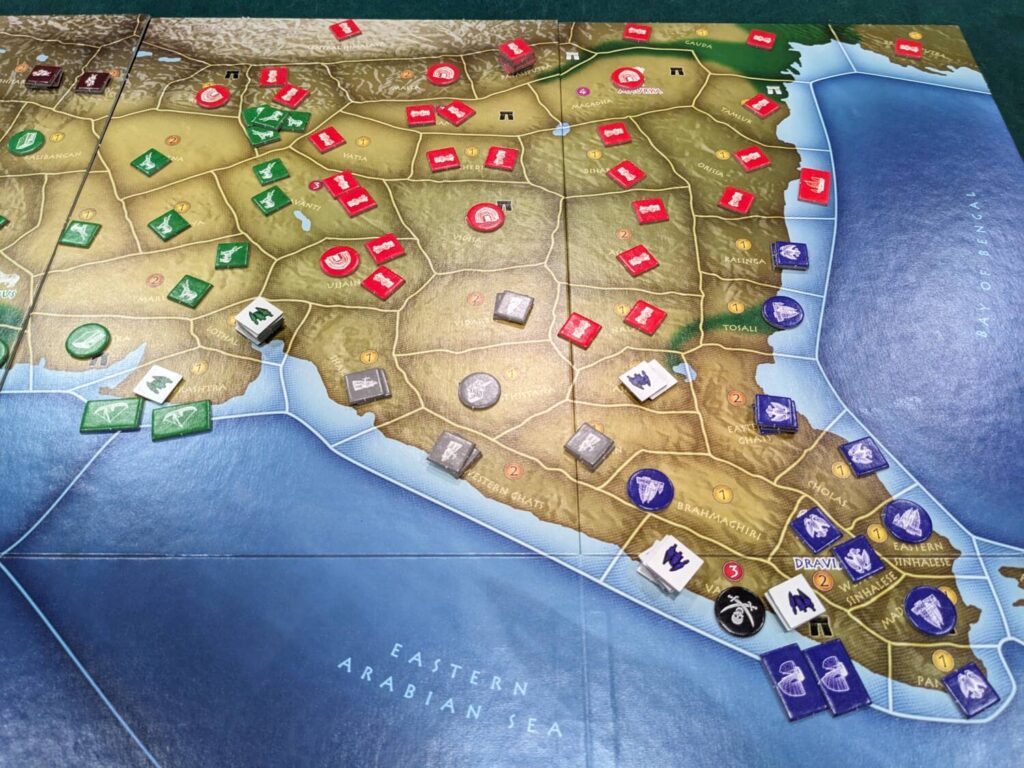
Having a smaller amount of cities means that when it comes time to get trade cards, you only get the less-valuable goods from the draw deck. In a couple rounds, it was comedy trying to get people to trade with me:
“Anyone have iron? I’m looking for as many irons as you’ve got.”
“Yeah, I’ve got iron. Do you have gemstones? Copper?”
[me, befuddled] “What decks do those come from? I only have cards from the first four decks because I only have four cities.” [look of shock from trading partner] “Oh, wow. No, listen, if you don’t have anything of value, I’m not sure we can work anything out.”Mega Civ became a game of haves and have-nots. In many ways, I like this; there is essentially no catch-up mechanism built in, because it was designed 40 years ago when people happily accepted longer playtimes and a complete lack of in-game mitigation efforts for players getting blown out. (Diplomacy, anyone?) There is no process for the player with the fewest points to be exempted from calamities or tech discounts for a player that is basically out of the game.
You’ve just got to sit there and, well, “learn from your mistakes” or something. I don’t remember making that many mistakes, but random event cards will do that to you.

5:45 PM
After successive events reduced the Indus community to near rubble, then a rebound, then more rubble, then a rebound, the proverbial straw that broke the camel’s back was dealt.
During a trade with Brian (who in my view had this game essentially locked up because he had 17 Civilization Advances cards when some players only had half as many), I was again looking for low-level items that I could use to trade as a set for a card that allowed me through the next gate in the AST structure.
Brian obliged, giving me something like two fruit cards, and for his third trade card, he handed me Iconoclasm and Heresy, which is a calamity card that is as bad as it sounds. I was going to have to reduce four of my five cities during the calamity phase. I didn’t have any techs that would reduce that number, so I was going to start my next round with a single city.
My game was already over at this point, but after Brian gave me the look that screamed “sorry, but this is Mega Civ”, I had to laugh. I was seven or eight hours into a game and I decided that trading just wasn’t for me anymore. I was pretty sure that Mega Civ also wasn’t for me. These trades had been brutal and you have to do trades to buy cards, so you can’t just sit out.
I walked over to a window in the gaming area, and stared a thousand-mile stare at no one in particular. I was done, and it was all hitting me at that moment, even though the game wasn’t over.
During the break between rounds, I noted to the group that Brian must have a sizable lead and I would be open to conceding to him if others were down. John put it to the table; Brian, to his credit, looked like he knew what we all knew, so at least he wasn’t the one looking to push me into total insanity. But, the table wanted to keep going, so we played three more rounds to ensure that someone kicked off the end-game condition of reaching a step on the AST that signaled the end of play.
I stopped trading for two of the last three rounds, opting instead to focus on buying low-level cards with the discounts I had piled up with previous purchases and top-deck draws. When others approached to offer me another supposedly sweet deal, I turned them down by reminding them I was in the clay/ochre/iron/papyrus market, trying to score low-level scraps without having any good deals in return. In the one turn I did commit to a trade, I got a Barbarian Horde calamity card handed to me, but I had enough defense with my technologies to blunt the negative effects of that transaction.
It was during this final window where the downtime in Mega Civ really hit me. This was more relevant in part because our players moved so quickly during their turns. I really can’t imagine a scenario where 18 people are playing Mega Civ across the larger map and even a single player takes a while to finish buying new cards. Each of our rounds took about 30 minutes, longer when we had more conflicts (battles are completely deterministic in Mega Civ, another excellent feature) or when we had a longer list of disasters that needed to be resolved.
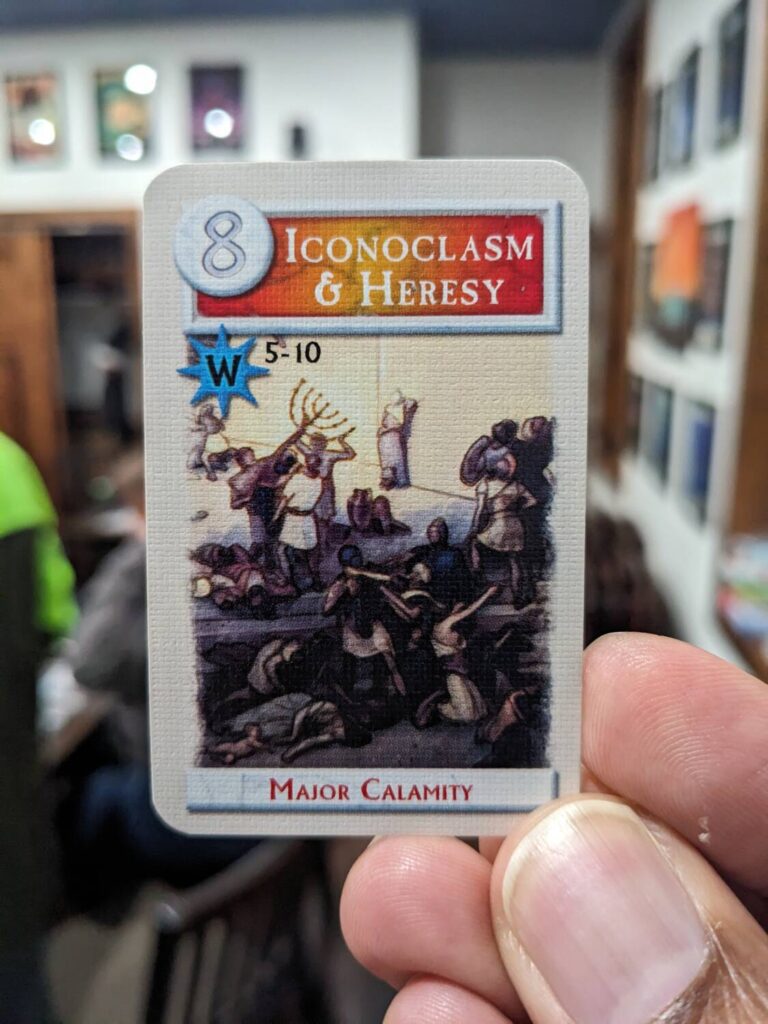
8:45 PM
We got to the end of the end just before 9 PM. As we all expected, Brian won, although he only won by about a dozen points. Mega Civ changed the scoring mechanic from Civ/Advanced Civ, where scores usually ended up in the many thousands (similar to an 18xx experience). In Mega Civ, scores seem to give you the feeling that you were really in the game until the very end, even though it didn’t feel that way during the game. (Six of the eight players had scores in the 70s, 80s and 90s, while John had 115 and Brian 127). Scores are very simple to compute: add the score aligned with your spot on the AST to the value of your Civilization Advances, and that’s your total.
In the rare case that I play Mega Civ again, I want the old time scoring: hundreds of points for your place on the AST, points for the value of the cost of each Civilization Advance, points for cities, points for leftover resources, points for everything. That way, you really get a sense of how well you did against the other players at the table.
I was surprised at how I felt at the end of the game. Mega Civ is an experience, man, something that really needs to be played by anyone who loves gaming. Even though I didn’t have the best day of my tabletop career, I don’t regret it one bit because it was so funny talking smack in-between turns even as I was getting demolished at the table. I was not tired, but I did struggle to keep my attention for the 10 hours Mega Civ requires to get through the game.
The first half of the day was a blast, despite the challenges. The second half? Not so much. I still like the idea of civ games but I prefer the execution of civ video games more than tabletop ones. That said, I really enjoyed my single play of the board game Civilization: A New Dawn and I always like 4X-style board games to give you that feeling of a world that completely changes over the course of a multi-hour shift with friends.
A big thanks to John, Beth and the other players for giving me a peek into the Mega Civilization madness. I have to agree now that I’ve seen it—it is epic!!





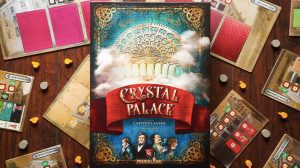

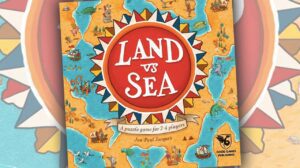





Civ and it’s follow-on iterations are, as you say, brutal. But I love those games they are a good kind of stress for me.
Calamities are supposed to be used as a tool against the leader(s).
I’m sorry you had this experience. If a newbie is doing poorly, hammering them with calamities is *not* f-ing cool. The idea is to get them to play again next time, not alienate them from the game.
Folks that desperate for a win are kind of sad, and they make it hard to get others to the table.